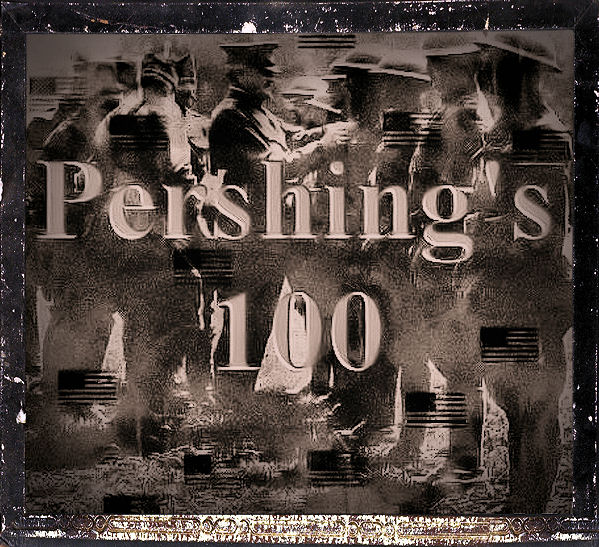The Story of the American Expeditionary Forces |
 General Headquarters |

|
"A List of One Hundred Individual Acts of Extraordinary Heroism Performed by Officers and Soldiers of the American Expeditionary Forces"
Once Lost and Almost Forgotten, But Retrieved from the National Archivesby
Bruce Powell of Atlanta, Georgia

First Notice
Background The document referred to in the newspaper article above was actually a 24-page cablegram sent from General Pershing's Headquarters [initialed by Pershing] to Secretary Baker on January 9, 1919 only two months after the armistice. It appears to be a response to a request forwarded by Mr. Baker to General Pershing earlier for hard stories about the members of the AEF to help with future fund raising efforts. After a brief introduction that includes the quote above about "one hundred acts of individual heroism. . ." the remainder of the document is an semi-alphabetical listing summarizing the deeds of each individual. Typical is this listing for Private Robert L. Blackwell of Hindles, N.C.
After its delivery, the information was distributed to the press through governmental information agencies. It's most dramatic exposure came in a series published in the summer of 1919 by The Ladies Home Journal. That article presents the individual summaries - slightly rewritten - and is most notable for sketches of many of the subjects. Over the decades memories of Pershing's 100 faded considerably; many contemporary students of the AEF [like the editor of the Doughboy Center] have read much without ever encountering the term. Enter Bruce Powell One day a few years ago, an Atlantan named Bruce Powell was visiting a small state park in Arkansas named after a First World War veteran name Herman Davis. He learned that Davis was considered Arkansas's most decorated soldier of that war and was a member of a group called Pershing's 100. Not many details, however, were available on the 100 -- what the criteria were for selection, who the other members were and so forth. Bruce Powell, though, with his curiosity aroused wanted more information and began a quest. The rest of the material in this article is primarily from Bruce's long, determined research effort. After many false leads and many prematurely raised hopes, Bruce went to the National Archives and did his own digging. He struck gold and found the original document. Subsequently he provided a copy to the Doughboy Center and we present it now for our readers in slightly abbreviated form. A Few Observations about the List There are a few things that need to be pointed out about Pershing's 100. The listing was produced in a rushed, hectic period, right after the war ended, as the AEF was both assuming occupation duties in Germany and starting to send troops home to America. Many of the great achievements of the AEF were still being recorded and forwarded to headquarters. Consequently, a number of individuals were overlooked. For instance, less than half of the Medal of Honor awardees from the Great War are included on the list. Alvin York would be the most conspicuous of these missing candidates, as well as Air Service heroes such as Frank Luke and Eddie Rickenbacker. Another issue becomes clear when the listing is closely scrutinized. It appears that certain units -- the 132nd and 354th Infantry with 13 selections between the two regiments come to mind -- were very prompt and diligent about forwarding requests for decorations. On the other hand, the Army Brigade of the Second Division and the entirety of the 3rd and 4th Divisions, some of the most active and effective units of the AEF, had but a single selectee amongst all of them. This is not meant to diminish at all from the achievements of those who made the list. It's just a caution that it is not a comprehensive summary of the achievements of the members of the AEF. One last point: It seems no one at General Pershing's headquarters had time to count the list of nominees. There are 101 men listed on Pershing's 100. As one of Vonnegut's characters says, "So it goes." The list is presented in four parts. Just use the icons below to navigate between pages. |
|
Sources and thanks: Bruce Powell of course is entitled to full credit for researching this article. He also provided sketch drawings used in the LADIES HOME JOURNAL presentation of the 100. Peter Lemon and Doug Sterner of the Homeofheroes.com website furnished additional portraits of the individuals. Homeofheroes is the most complete presentation on the Internet of America's Medal of Honor recipients. Click here to visit their site. MH |
To find other Doughboy Features visit our |
Membership Information  Click on Icon |
For further information on the events of 1914-1918
visit the homepage of |
Michael E. Hanlon (medwardh@hotmail.com) regarding content,
or toMike Iavarone (mikei01@execpc.com) regarding form and function.
Original artwork & copy; © 1998-2000, The Great War Society